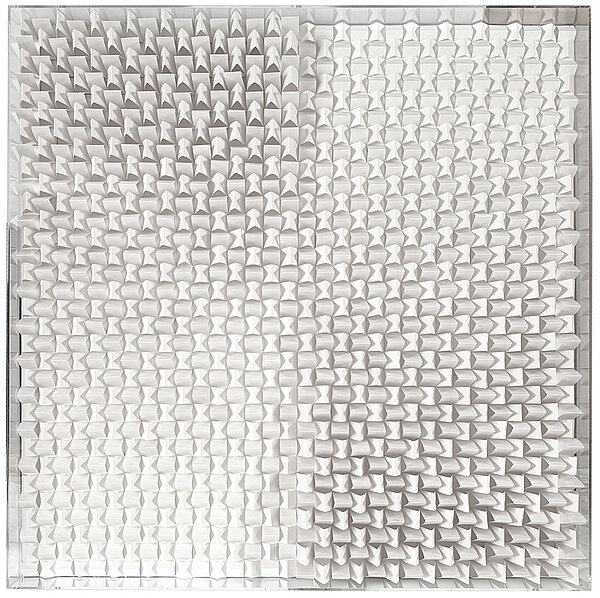Jiří Hilmar
Weiss auf Weiss, 1976
[White on White]
Folded paper, Perspex, wood
100 x 100 x 15 cm
© VG Bild-Kunst, Bonn 2025
Photo: Gerhard Sauer
Jiří Hilmar belonged to a generation of young artists in sixties Czechoslovakia who turned increasingly to constructive principles in their work. Thus in 1967 he was co-founder of the Club of the Concretists in Prague, which also maintained contact with other European avant-gardes through its exhibition activities. Unlike many artists of this direction, whose turn to a rational grammar of forms was often accompanied by rejecting the subjective expression associated with art informel, Hilmar explained his aspirations to a renewal of art by the wish to give his own particular twist to the spirit of liberalism and the sense of new departures that was germinating in his homeland in the sixties. With the principles of logic, geometry, and mathematics he employed in his kinetic works and object boxes, he arrived at his own modern answer to Prague’s art and literature steeped in mysticism and the baroque.
Between 1966 and 1980 Hilmar created an extensive series of mainly monochrome, but also polychrome patterned paper reliefs that are pieced together according to strict formal criteria and generate a wealth of visual impressions. The piece Weiss auf Weiss [White on White] from 1976 is a late example of this. A square Perspex box presents a great number of folded paper strips mounted systematically to the picture carrier so as to alternate between a vertical and horizontal orientation. At first the viewer sees that the serial microstructure is divided up by a macrostructure: the subtle change from light to shade across the field of folded strips created by the incoming illumination allows two large rectangular fields to be distinguished, which, tipped towards each other, set the vibrating structure in additional motion. Viewed from close up one can see the raw materiality, the tensile force and sculptural quality of the split surfaces and also along the creases and edges; at a greater distance, though, the individual parts seem to fade away and the work transforms into a flowing manifestation that becomes a white, vibrant murmur.
After emigrating from Czechoslovakia and moving to the Ruhr District, where in 1974 he settled for the best part of forty years in Gelsenkirchen, Hilmar soon adopted a new way of working. With the changes this brought about in his everyday experiences, the wooden sculptures, the wall objects and projects in public space that he created during this period were the result of his inquiries into the fraught relationship between nature and industry. (Hsiaosung Kok)
Jiří Hilmar
1937 born in Hradec Králové (today: Czech Republic)
Lives and works in Petrovice (CZ)


